YouTube is fascinating. I’d like to say that it has democratized entertainment — putting programming into the hands of the people — but it’s not quite a democracy. Even unpopular channels can crank along, creating videos for an audience in the single digits with no risk of cancellation and no pressure to evolve or reach more people. It continues as long as the person who owns that channel stays interested. It’s a hobby, but one that just so happens to observable by people almost anywhere on the planet.
The vast majority of channels on YouTube are self-funded. We’ll ignore channels that are part of a brand’s marketing arm — their videos are essentially digital advertising — and focus on people who create videos, more or less regularly, about topics that interest them. These creators pay for a camera. They pay for their internet connection. They may — and often do — pay for more than that, but that’s all they need.
For a negligible investment and with the approval of no other human being necessary, people can start sharing their passions with the world.
It’s important to keep this in mind, because it’s exactly what enabled YouTube to flourish and become a legitimate medium of its own.
In television, you have a crew. You have a cast. You have advertisers. You have censors. You have strict schedules. You have executives. In short, there are a lot of people you need to hire, keep happy, and work to retain long before you get to create and distribute any content.
On top of that, there’s the audience. People sitting on their couches with a remote control in their hands at 8:30 p.m. have a level of quality they expect from broadcast television. Not in terms of the writing or creativity, but in terms of the production. These are things of which they usually won’t be conscious. Things like the attractiveness of the actors, the familiarity of the setup, the rhythm of the show, the formula of the plot, and — we can’t forget — the precise length of the experience.
Do any of those things truly matter? Of course not, but audiences are comfortable with them. It’s what they expect. Mess with them and you don’t just end up with a show that doesn’t appeal to someone; you end up with something that feels wrong.
Let me use a real-world example here: This is the second-most-popular video by Technology Connections. (The most popular just happens to be video-game related, so we’ll skip that; I don’t want to overlap too much with what we’re going to say about The Angry Video Game Nerd.)
Click that link. You don’t need to watch beyond the opening second or two (though feel free to watch the entire thing if you are interested) to see that this is the sort of thing that would baffle audiences if they stumbled upon it on NBC…or even PBS.
I say that with love. Technology Connections is an excellent channel and — in my humble opinion — is a good representation of the absolute best of YouTube. Alec Watson is an intelligent person talking about fascinating things in a way that a fucking imbecile such as myself can follow.
Let’s imagine this same host with this same idea in 2004, the year before YouTube went live. Miraculously, Watson has landed a meeting with television executives. He pitches them the concept for exactly what you see in that video. How many confused looks would you see in that room? The answer depends solely on the number of executives present.
He wants to do a show about air conditioning? No, he’d cover air conditioning in this episode, then color theory in another episode, then maybe hand-warmers, and then a ride at Walt Disney World. Okay, and he’ll explain how they work? Sometimes, but other times he’ll just point out things he finds interesting, or he’ll try to make his own lava lamp, or he’ll tell people why not to buy a product. Okay, well, that’s not going to fly with advertisers…who will host this? Watson will, with a disheveled head of hair and a thrift-store blazer over a nerdy T-shirt. Also he will write it himself and deliver puns with a monotone directed into one camera that never moves. Good lord…at least he can fill a time slot, right? Of course, except for the times when he can’t; depending on the topic he’ll produce an episode running anywhere from six minutes to an hour and a half.
Does Watson’s show make it to air? You already know the answer.
Even if the network wanted to move forward, they’d hire researchers so that he could cover more topics more regularly, they’d hire editors to keep everything snappy and engaging, they’d build a set instead of letting him use a cluttered background, they’d probably hire someone a bit more at ease in front of the camera…and once all of these things are addressed, is it the same show?
Technology Connections could not have existed in 2004. Television would have been his only option, and his job wouldn’t be discussing household objects that he finds interesting; his job would be keeping his bosses happy and getting more people to tune in each week. I can’t speak for Watson, but the odds are good he’s passionate about doing one of those things more than the others.
2005 hits and everything changes. Technology Connections can exist as we know it and as Watson wishes to make it. Vloggers can exist, rambling about their mundane lives without preparation or direction. Musicians can find audiences without having to go through record labels or even their local music scene. Friends can write and produce comedy skits without trying — perhaps without even desiring — to get the attention of Saturday Night Live.
Suddenly, practically overnight, anything goes. Things that no network executive would ever commission are attracting legions of dedicated fans. People unbox toys on camera, annoy professional scammers, or throw eggs at things. Millions of people are suddenly enthralled by everything they would never watch if it were on television. Lucas Cruikshank can yell in a pitch-shifted voice, Tom Dickson can stick objects into blenders, and James Rolfe can spew profanities at old video games.
And I don’t mean profanities that are humorously bleeped. I don’t mean TV-friendly profanities, like “Hell” or “frigging” or something that a scriptwriter made up because he couldn’t have a character say “fuck farts.” I mean long stretches of obscenity that may or may not contain the germ of valid criticism.
However much they despised a film, Roger Ebert or Rex Reed or Gene Shalit would have lost their jobs if they resorted to foul language when describing a film on the air. (And may have found themselves embroiled in scandal if they were taped doing so off the air.) For Rolfe, on YouTube, that would be his entire appeal.
There might be no better or simpler illustration of just how clearly YouTube served as television’s puckish opposite.
Rolfe — a film buff and budding director — created his Angry Nintendo Nerd character in 2004, before YouTube existed. There was no way to share those earliest episodes with a wide audience. They were confined to a VHS cassette, sitting in a drawer. Making them amused Rolfe and a handful of his closest friends. It could go no further than that.
When YouTube came around, he uploaded the two episodes he’d already made: reviews of NES games Castlevania II and Dr. Jekyll & Mr. Hyde. With a virtual snap of his fingers, something that had once amused only him had a chance to amuse the world. And it did.
Rolfe continued reviewing games with his character, soon to be renamed the Angry Video Game Nerd, and he did it only because he’d found an audience who wanted more. Left to his own devices, he would have ended up doing something else with his life. Why not? He’d made his couple of profane game reviews and gotten his share of amusement from doing so. There would have been no reason to continue.
The AVGN was one of YouTube’s earliest true success stories. Rolfe inspired countless imitators who rarely had even a fraction of his appeal. He signed a deal with another website to produce videos for them. He found celebrity fans, including Troma Entertainment’s Lloyd Kaufman. Allow me to emphasize that: The film director who created so many movies that had entertained Rolfe was now being entertained by Rolfe. I can’t speak for Rolfe any more than I could for Watson, but that must have been surreal.
Yelling bad words at old video games in his spare room first gave Rolfe an audience, then a source of income, then a career that continues to this day.
As his mass of imitators know — consciously or otherwise — Rolfe’s ascent is neither easy to understand nor easy to duplicate. There was luck involved, certainly. There was an element of perfect timing, with Rolfe having episodes ready to go in advance of YouTube becoming popular enough to support its own star. But the AVGN was more than the superficial thrill of seeing a man in a button-down shirt get angry at the same games that made us throw our controllers as children.
The AVGN was James Rolfe. Anyone could yell at a TV screen, but nobody else was James Rolfe.
I have to hypothesize a bit here, but I think Rolfe’s appeal was rooted less in what he was doing than in who he was. He’s an eminently likeable person. The AVGN is — and always was — a character. The actor behind the character was clearly soft spoken. His genuine love for the games he was yelling at was obvious. He was a funny person who understood the power of language, the cadence of comedy, and the necessity of careful editing.
There was a person there, and he was a person we liked. The fact that he was on YouTube rather than CBS meant (among many other things) that we felt closer to him. There were fewer degrees of separation. There was no filter. Rolfe clicked “upload” on one end and we clicked “play” on the other. Nobody and nothing stood between Rolfe making a joke and us laughing at it, making him feel as much like a friend as he felt like an entertainer.
We will address this question more thoroughly in the next two films we cover, but for now it’s at least worth raising it: How, exactly, does somebody take this very particular appeal and translate it into a film?
With 2014’s Angry Video Game Nerd: The Movie, the answer seemed to be “quite poorly.” I say “seemed to be” because, prior to this review, I’d never seen it. I could only go by fan reception, which seemed to range from abysmal to “well, it looks like he was having fun.”
The truth is, of course, more interesting than that. Having now watched the film I can see why so many people dismiss it, but I’m not sure it is worth dismissing, even if it’s not great.
I don’t know what inspired Angry Video Game Nerd: The Movie, nor do I know what inspired the other two films we’re covering this year. It’s very possible that in any case or in every case, somebody woke up one morning with a profound desire to get one specific story out and then set about doing so.
More likely, I think, these creators realized that they had audiences. Real audiences, who would be willing to support other creative endeavors. Audiences who, hopefully, would be willing to take a chance on a decidedly different format from the one that attracted them in the first place.
Everybody believes that they have some film inside of them, or story or novel or painting or composition, and I’m willing to believe that every one of these people is correct. They may never spend the necessary time to develop their craft or may never end up with an audience interested in whatever they produce, but each one of us has something inside that we’re capable of producing.
When you already have millions of people tuning in regularly to see what you have to say, well, what are you waiting for? Show them what you can do.
Rolfe could — probably pretty easily — have just written and performed an extra-long game review. He could have covered a bunch of different games while a loose narrative unfolded in the background. He could have created an entertaining history — or even a documentary — about the making of some particular game or series. In short, he could have given an audience exactly what they were getting from him already, only more of it and with higher production value.
Instead, he pulled the camera back a bit and let the AVGN have an adventure that had nothing to do with anger, hardly anything to do with video games, and which had the word “nerd” in it a few times. It’s the same character, but not the same context.
It’s taking a character designed and developed for one purpose and forcing upon it a different one. It’s sending Indiana Jones into space, or sticking Cookie Monster into a hospital drama. A character we enjoyed when he did A is now suddenly doing B, and whereas it cost us nothing to enjoy A, we’re being asked to part with our money to experience B.
Rolfe is an intelligent enough guy to understand this. He must be; he shaped the entire plot of Angry Video Game Nerd: The Movie around the character’s refusal to review a game. He’s aware of his audience’s expectations and he has a bit of fun toying with them. But being aware that the audience wants something different isn’t quite enough; it’s what you do with that awareness that matters.
Ultimately, he doesn’t do much with it.
The film makes overtures at being “about” video games. Specifically, the notoriously terrible E.T. for the Atari 2600, a game which is frequently — and not totally fairly — blamed for the video game crash of 1983. The AVGN finds himself badgered by friends and fans to review the game, and early in the film he sets off to Alamogordo, New Mexico, the real-life location where unsold copies of E.T. were destroyed and buried.
All of which sounds like this film has quite a lot to do with video games. Really, though, E.T. could be subbed out for anything else. And, in fact, the film does sub it out at least twice: first, and most directly, for a copyright-friendly equivalent called Eee Tee, and then later for Area 51.
Half of the AVGN’s name stands for “video game,” but here it’s really just an excuse to get him on the road. That, in itself, makes sense; Rolfe may have had a road movie in mind with lots of jokes to make along the way. All E.T. (or any game) needs to do is serve as a destination; the journey is the story.
Or so it would be, except that the entire journey is skipped right over. The AVGN and his two hangers-on might as well warp directly to the New Mexican landfill for all that the trip itself matters.
That’s because the trip itself is no more interesting to Rolfe as a filmmaker than E.T. is. What he really wanted to make, it seems, was a comedy about breaking into Area 51. Everything else just happens, and any time it ties into video games — or, indeed, the AVGN — it feels incidental.
I’m of two minds about this. On the one hand, Rolfe could obviously have made a non-AVGN film with very, very few tweaks to this script. James and Friends Meet an Alien would be damned similar to what we have here and it would be free from the expectations people have of the AVGN character.
On the other hand, Rolfe — correctly — understood that far more people would watch (and purchase) the film if it had the AVGN name on it. If he wanted to make more money, it needed to be about the AVGN. Ditto if he wanted to secure distribution, if he wanted to attract talent, and if he wanted any kind of media attention at all.
He could make a movie without the AVGN, but then he’d be back to where he was before he created the character; he’d be making a film with pocket change and a few close friends that nobody else would care about. If you think I’m being harsh here, ask yourself how many people care about The Wizard of Oz Part III: Dorothy Goes to Hell or The Head Returns, two post-AVGN film projects by Rolfe that you likely didn’t even know existed.
Rolfe could make a film about three dimwits rescuing an alien or he could stick the AVGN name on it, feint toward some vague video-game content, and reap infinitely higher viewership and profit. He’d been doing the former for decades. I can’t and won’t blame him for trying the latter. I understand how tempting it must have been.
Of course, we all know what happens after the people who lined up for the AVGN actually see the film.
I can’t and won’t blame them, either. Rolfe set an expectation for his audience, and it’s not his audience’s fault if the film didn’t match it.
Fans who had loved — and in some cases grown up — watching him play the old games they remembered and put into profanity all of the things they were never able to say watched a movie that contains none of the games they remember and nothing in the way of observation.
What’s worse — even if it’s understandable for an indie film — is that any game footage we do see is the same kind of off-brand equivalent we might see on a sitcom…a sitcom made by writers and executives who probably don’t care enough about video games to get them right, and won’t bother trying because they don’t think their audience will care, either.
Rolfe’s sincere love of the medium — the love that inspired the AVGN series and which was felt by every viewer who ever enjoyed it — was absent, because the medium wasn’t putting in any real appearance here at all. Rolfe has no nostalgia for the bland recreations we get here, the sort of thing we might have seen on Full House if the show ever had to let us see the TV screen for some reason. He can’t have any nostalgia for these games, because these aren’t real games. For the same reason, we can’t have any nostalgia.
The common ground we felt with Rolfe does not exist within the confines of this film. He can call it the AVGN, and dress up like the AVGN, and repeat the same strings of curse words we remember from the AVGN, but the very heart of the AVGN is nowhere to be found.
What do we get instead? I’m not entirely sure.
Each of the films we’re covering this year seems to fall somewhere between the creators making a movie and the creators making fun of movies. There’s nothing wrong with poking fun at the very concept of film — parody does sometimes outlive sincerity — but it can also seem like a crutch, as though the filmmaker isn’t confident enough in their own talent to play things straight. “I was only kidding” is an all-too-easy excuse. If an audience laughs, great. If they don’t, you don’t have to take it to heart.
Watching Angry Video Game Nerd: The Movie, I kept wanting Rolfe to take it just a hair more seriously. Some of the biggest laughs came from the parodic moments — his friend turning into a dummy whenever he takes a nasty fall, or a battle segment being played out by toys instead of people — but they didn’t help me to enjoy the film more.
They were a second or two of laughter rather than anything that enhanced or improved the experience of watching the movie. Instead, moments like this just muddy the film’s reality and make it difficult to know what we’re meant to take seriously.
Rolfe overall gets close to making a screwball comedy as opposed to a parody, and I think the film would have been stronger if he focused on that aspect of things.
There’s a scene in which he dresses up as an alien and launches a homemade UFO into Area 51. It’s in no way realistic but it is at least anchored in a recognizable semblance of reality. It’s a buffoonish sequence, but it works for a buffoonish character in a buffoonish movie. Cutting to a prairie dog puppet saying curse words simply because that’s ostensibly something somebody might laugh at…well, even if that does work, it’s incongruous. It doesn’t fit. (And it also doesn’t work, but that’s beside the point.)
For two more-easily comparable examples, we can look at the film’s pastiche sequences.
In one, the AVGN essentially finds himself in the middle of a zombie film. Rolfe, horror buff, gets to live out what I’m sure was a lifelong dream as he’s munched on by the undead. The AVGN then wakes up from the nightmare, and rightly so, because zombies would break the reality of the film. Rolfe, correctly, corrals this sequence off from what actually happens in his movie.
In the other, the AVGN’s buddies essentially find themselves in the middle of a kaiju film. Rolfe, again a massive fan of the genre, gets to live out what I’m sure was a lifelong dream by directing a huge monster as it smashes through a model city. The difference is that this actually does happen in the movie. It’s not a dream. It breaks the reality as much as zombies would, except that this has no narrative handwave. We are just suddenly watching a little bit of a kaiju film when the majority of the movie was grounded in a world we recognize by a logic we understand.
Again, I mean to make clear that either approach is okay. You can have wacky stuff happen in dreams or you can have wacky stuff happen in reality, but you need to decide before you make the film what things can only happen in dreams and what things can actually happen in reality. There is no wrong answer, but if you don’t have an answer — or your movie makes it seem like you don’t have an answer — people will be confused at best.
Rolfe didn’t make a parody, but he wants viewers to excuse Angry Video Game Nerd: The Movie whenever it briefly becomes one. The fact that it does keep abruptly becoming one (and then just as abruptly stops being one) is evidence of a lack of restraint on his part as a filmmaker. Then again, we may not need even need that evidence; the fact that Angry Video Game Nerd: The Movie is almost two fucking hours long is evidence enough.
It’s difficult to see a running time of 110 minutes on a YouTube vanity film and believe that the length is justified, and Rolfe seems to take every opportunity throughout the film to even further convince you that it’s not. Between fantasy sequences, montages of fans gushing about the AVGN, lengthy flashbacks, and a deeply strange animated tangent about his buddy Cooper’s wackadoo beliefs, the film didn’t just have opportunities for tightening up; it’s practically pleading with the audience to edit it themselves.
Speaking of tightening up, I guess I might as well talk about what little story there actually is in this film. I wish I could say that without sounding dismissive, but there are so many false starts, abandoned threads, and left-field developments that it’s less a narrative than a bulleted list of things that happen. Still, we’ve come this far…
Cockburn Industries decides to develop an intentionally terrible Eee Tee 2, expecting it to sell well due to its predecessor’s infamy. Coincidentally, somewhere else, the AVGN exists. A woman who works at Cockburn decides to get the AVGN to review and endorse the game. This inspires the AVGN to do nothing. Coincidentally, somewhere else, the AVGN’s friend Cooper exists and is inspired to inspire the AVGN to do something. The AVGN says no and then says yes.
The two friends and the woman arrive in New Mexico via the magic of editing, where the Eee Tee cartridges are buried. This angers a bunch of soldiers and government officials, because the kids might find Area 51 which is in a different state. Meanwhile, only one person in the world can tell them the secret behind the development of Eee Tee. Instead of finding him, the kids find someone else who can tell them the secret behind the development of Eee Tee.
A soldier kidnaps the woman and brings her to Las Vegas while a giant monster rises from Mt. Fuji and the AVGN’s friend plays Eee Tee which either causes an alien to escape from Area 51 or doesn’t have anything to do with the alien’s escape from Area 51, so the AVGN and the alien fly a plane and then the AVGN and the alien get out of the plane. Then it’s night time and the movie ends.
Watching Angry Video Game Nerd: The Movie is a weird experience, because it stumbles across as many terrible ideas as it does good ones and then can’t seem to decide what to focus on. It’s so disjointed that I often couldn’t even tell what I was meant to feel while watching it.
Near the end of the film, for instance, the AVGN’s friend kisses the woman, and they had so little to do with each other prior to that point that I expected it to be a joke, with the woman saying to him, “Why did you do that? Who even are you?” But instead I guess they’re in love. And, hey, good for them! Love is a wonderful thing. I just wonder if I should have seen any of it since I did watch the entire film and all.
Also, the woman pretends to be a nerd — I guess? — so that she can get closer to the AVGN and get him to endorse Eee Tee 2. But she also never makes a secret of who she works for or what she wants from him, so why bother pretending to be a nerd? And why does it feel like a betrayal when the boys learn that she doesn’t actually need glasses? She went through some degree of effort to lie to them, but the lie didn’t conceal anything at all. She comes to them in nerd form but is still openly trying to get them interested in endorsing Cockburn’s product. What was the point of lying if she wasn’t lying about the only significance she had in the story?
You can play with things like this — have plot developments happen due to expectation alone and have that be a joke — but I don’t feel as though the film actually builds to these moments as punchlines. They’re just things that happen, which might be another symptom the fact that the film can’t decide what constitutes its own reality.
It has some nice moments. I like the way it explores Rolfe’s own legacy, which is worth doing; there’s a reason I spent so much time discussing it myself up above. The fact that the vitriol he (sometimes literally) spews at terrible games results in people tracking down and playing those games instead of avoiding them is funny. It’s also a valid observation and a weird enough phenomenon that it’s worth poking fun at.
Then there’s the cast, and I can’t fault any of them. Rolfe is as naturally likeable as ever. Jeremy Suarez as his friend Cooper is perfectly fine. Sarah Glendening should get to do more than look pretty behind nerd glasses, but she’s fine with the material she gets.
The film does manage to intermittently shine with a couple of bit parts. The first is the AVGN’s boss, played by the consistently reliable Eddie Pepitone. Pepitone is a riot here, shifting from flattering the AVGN to verbally abusing him to pulling a gun on him, selling every step in the process. I don’t know how much of his performance was scripted and how much was improvised, but it’s a great little scene that is elevated for its craziness.
The other, maybe not coincidentally, is another crazy old guy, this time played by Stephen Mendel. Mendel’s general is fueled by pure rage and is quick to violence, which usually ends with him getting gruesomely injured. He’s funny, and due to the nature of the sight gags I’d guess most of his performance was dictated by the script. If that’s the case, good on Rolfe and his cowriter Kevin Finn, who here did manage to create a zany character without throwing the film’s reality off kilter.
I also liked the alien’s voice, which I could have sworn I recognized. I looked him up and it’s Robbie Rist, who has been in too many things to mention and I can’t possibly narrow down where I thought I knew him from. I did learn, however, that he played the notorious Cousin Oliver on The Brady Bunch, so good lord am I glad the guy still had a career after that.
I remember when Angry Video Game Nerd: The Movie was released. It came to a tiny little movie theater just a few blocks from me, and I had every intention of seeing it. I had some other things going on in my life at the time and the theater stopped showing it before I had a chance to check it out. Then I heard about the film’s negative reception. I still wanted to make up my own mind, but I felt quite a bit less compelled to seek it out.
Fans weren’t happy. I don’t think I saw anyone saying they liked it, at least not without qualifying the statement by adding “for what it was.” At worst, people started accusing Rolfe of misusing the funds that fans had given to him to make the movie. They called it a scam. They called Rolfe a thief.
They’re idiots. At this point I can safely say that I don’t like the movie, but I’m nowhere near moronic enough to suggest that I know how much the film should have cost or how much Rolfe obviously stuck into his pocket instead. Even carefully planned professional productions go over budget. They face unforeseen obstacles or see costs inflate from what they estimated. Nobody can know in advance what a film will cost; they do their best to estimate it and then do their further best not to exceed that estimate.
Angry Video Game Nerd: The Movie was neither carefully planned nor professional. Whatever it cost, it cost. And, frankly, I think people know that Rolfe didn’t use this as some kind of elaborate embezzlement scheme. (There are far easier ways to steal money from fans; just ask the Nostalgia Critic.)
Instead, the accusatory blowback was the internet’s predictably awful way of saying, “I did not enjoy your film.”
That sentiment, at least, I get. Rolfe put the name of his show in the title of a film that had precious little to do with his show. He stuck his character into a movie that neither needed nor benefited from that character’s presence. He was willing to gamble some degree of credibility against the potential for a larger audience.
I understand that temptation.
In that situation — being loved for one thing and really hoping to transfer that love to something else — I quite possibly would have done the same thing. And, like him, I would also have known the risk of taking that bet.
Even now, after watching the film, after knowing it would sour a decent chunk of his audience on him, after seeing that people would accuse him of criminal activity expressly on the grounds that they didn’t think his space-alien movie was funny, I can’t blame him.
For whatever reason, he wanted to make this movie. He did what he had to do in order to make it. In a very large and legitimate way, that is an achievement.
And in another way?
Well, it looks like he was having fun.
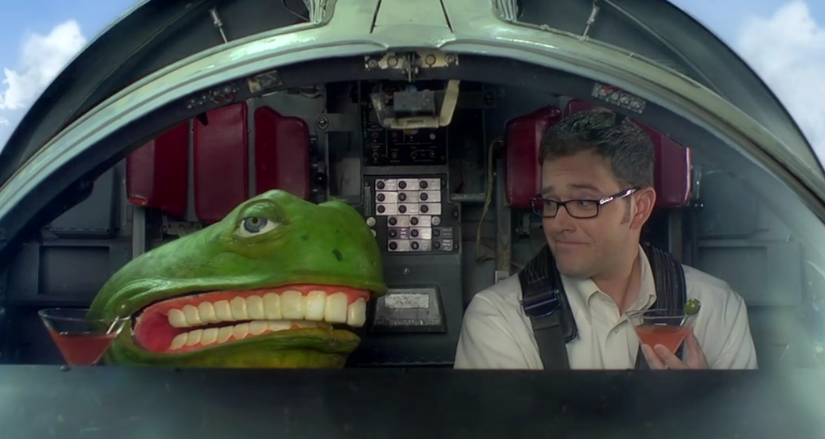
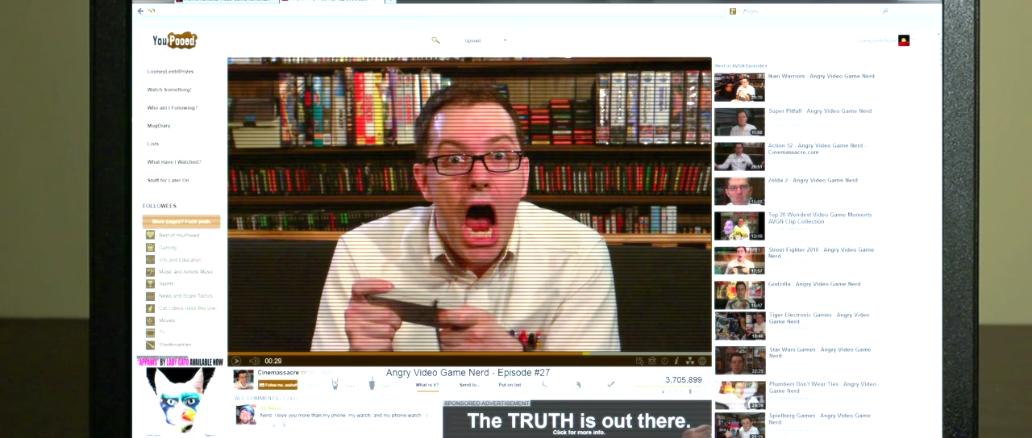
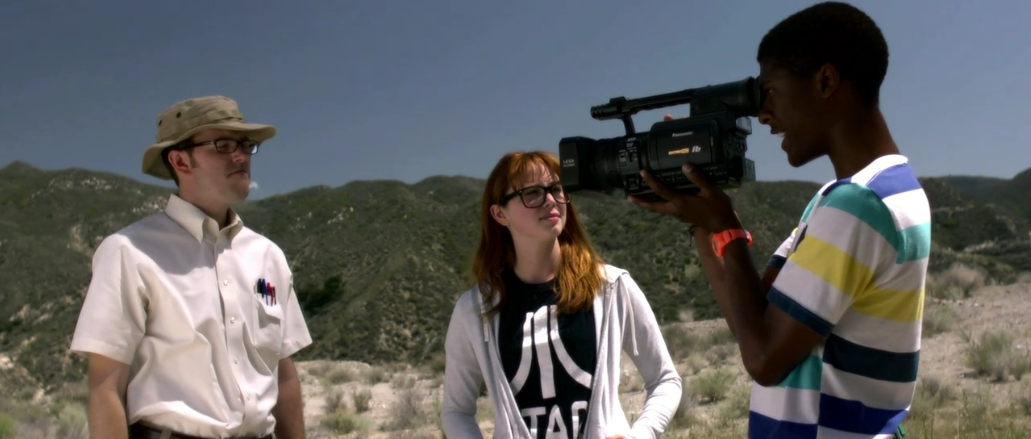

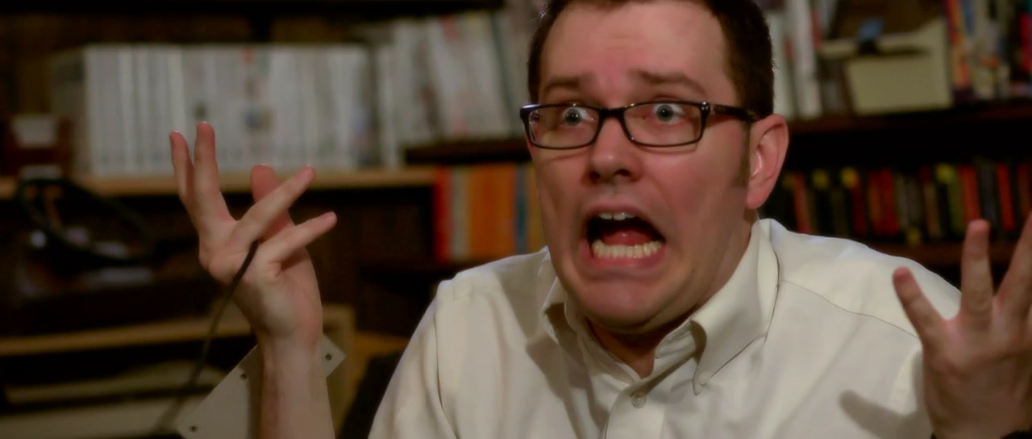


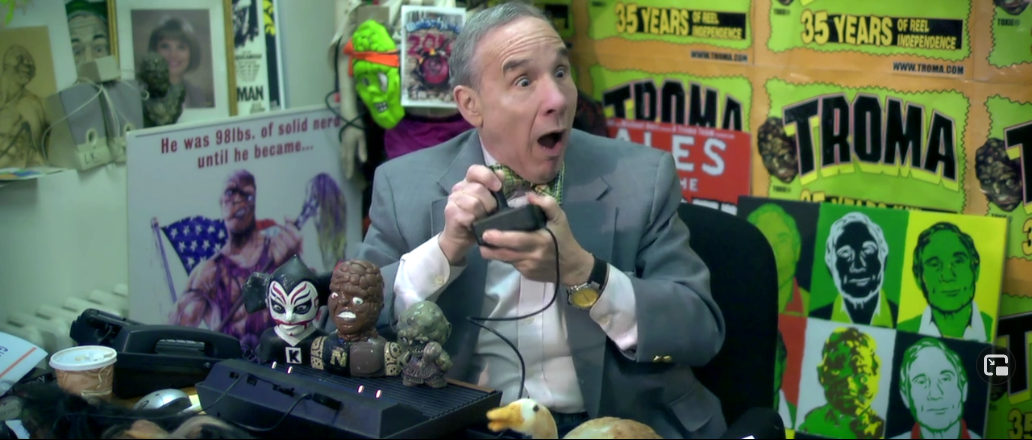
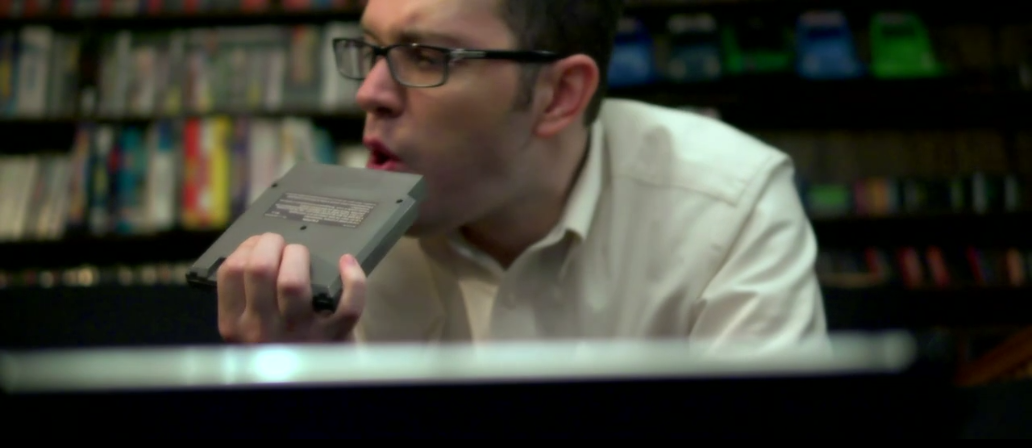


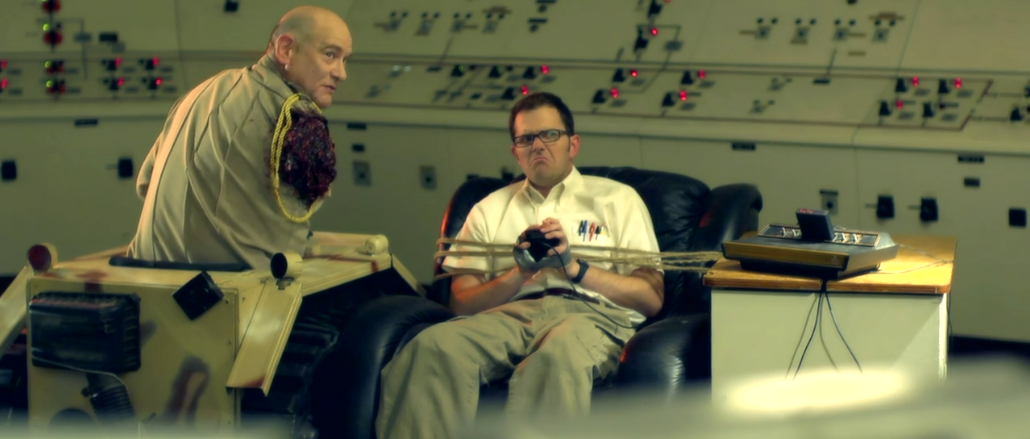
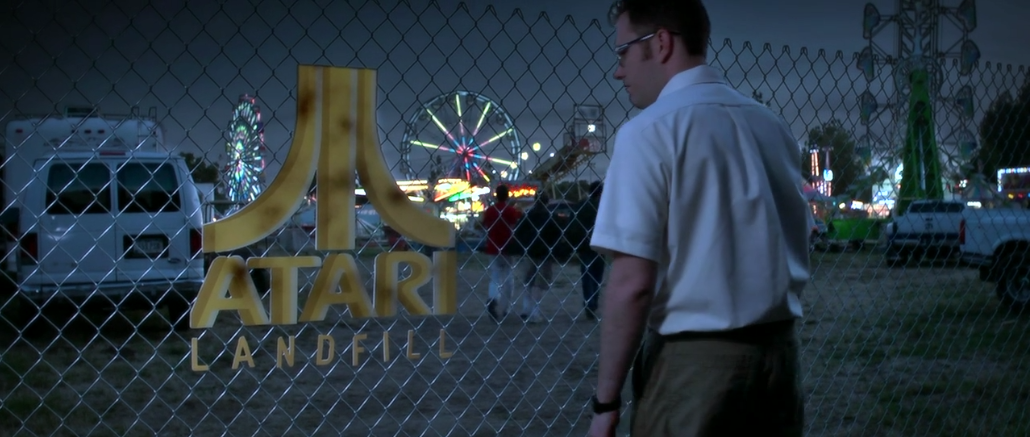

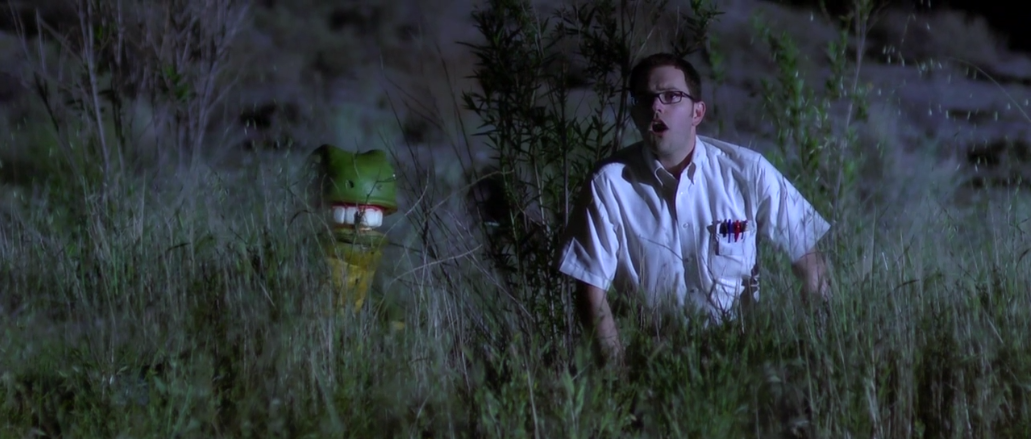
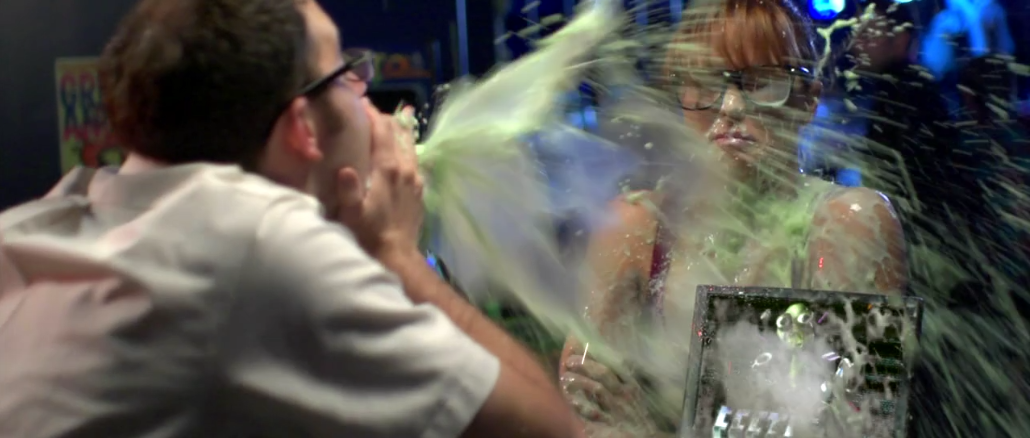
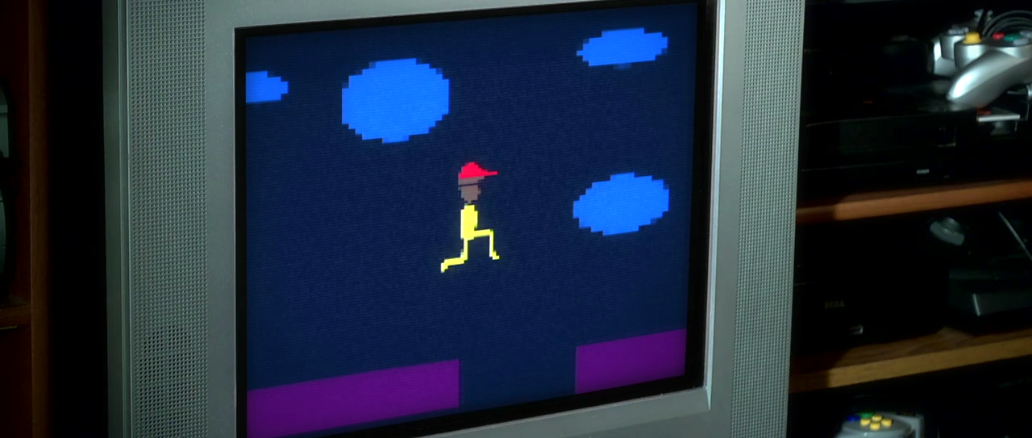
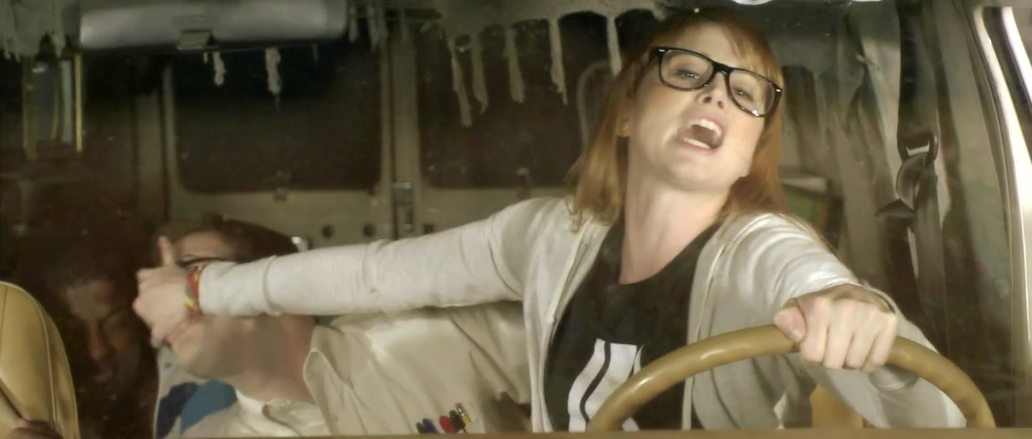


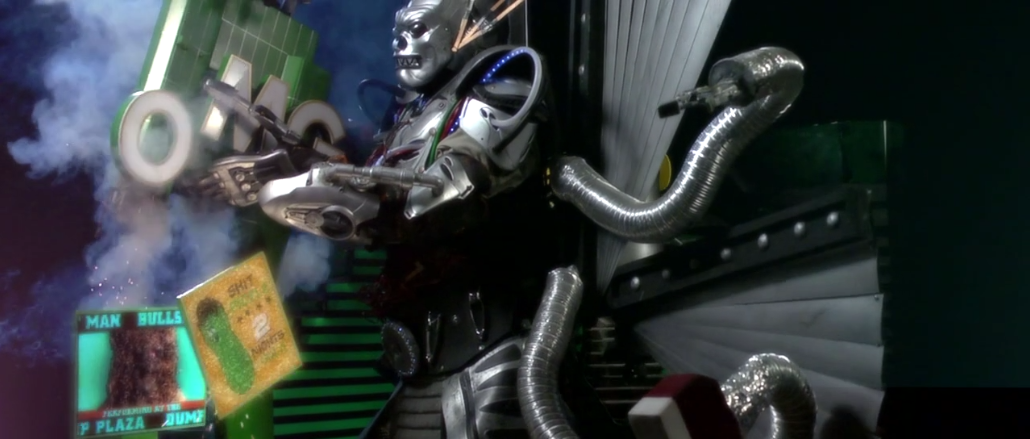
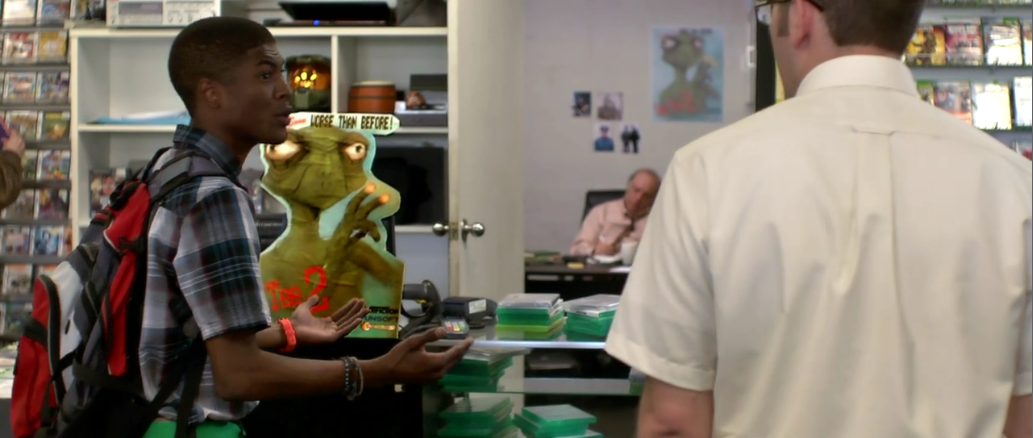
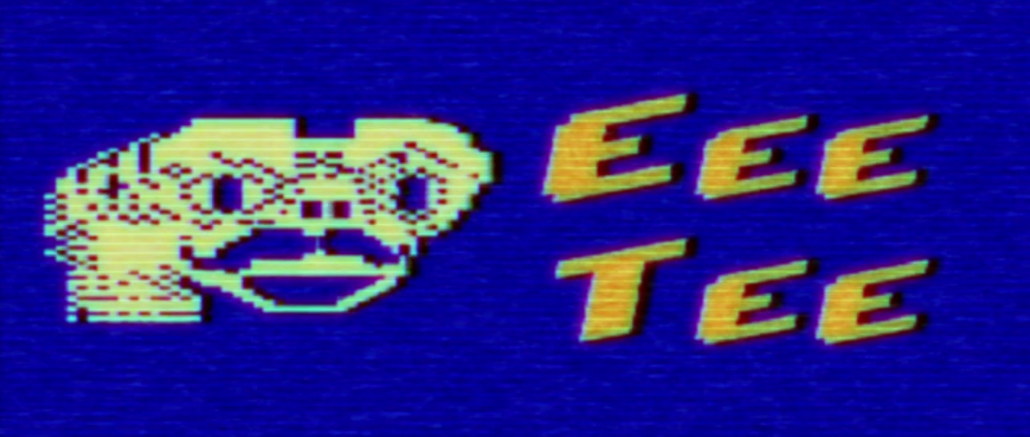
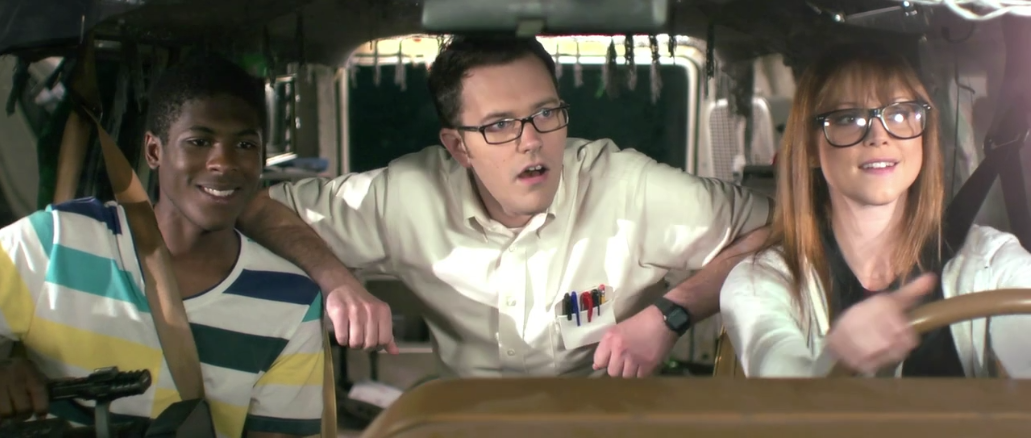

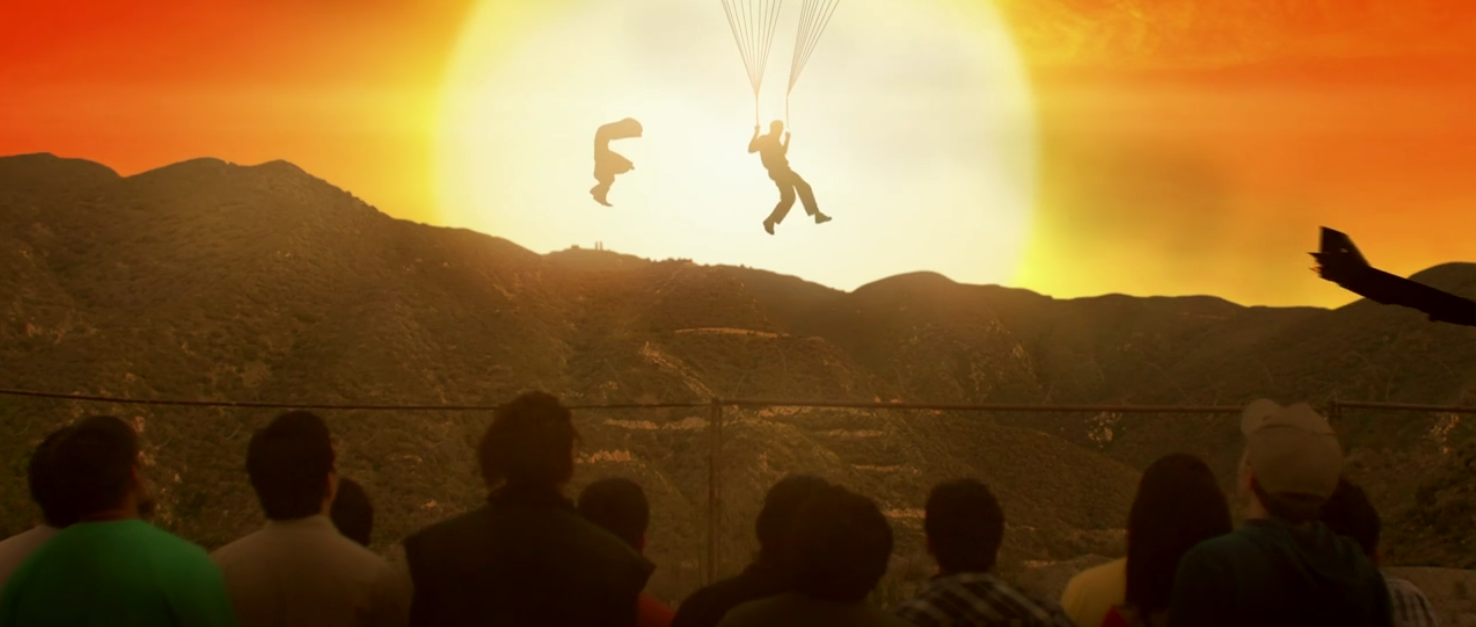
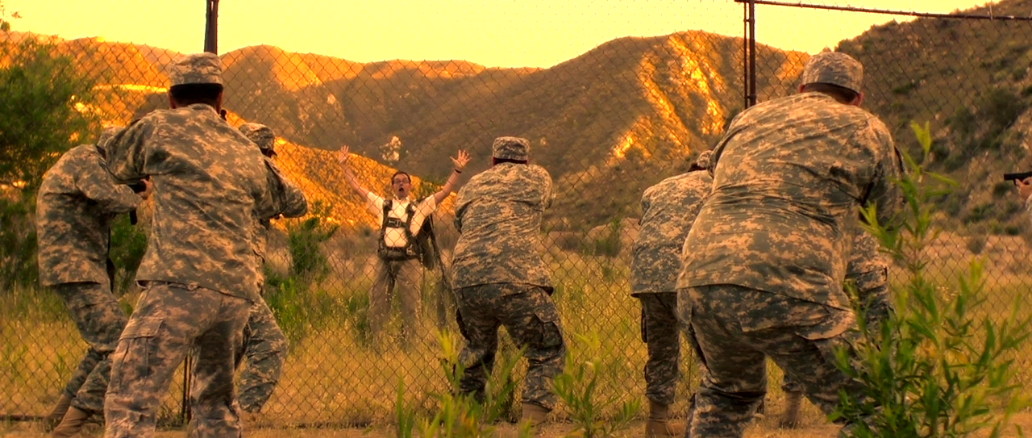
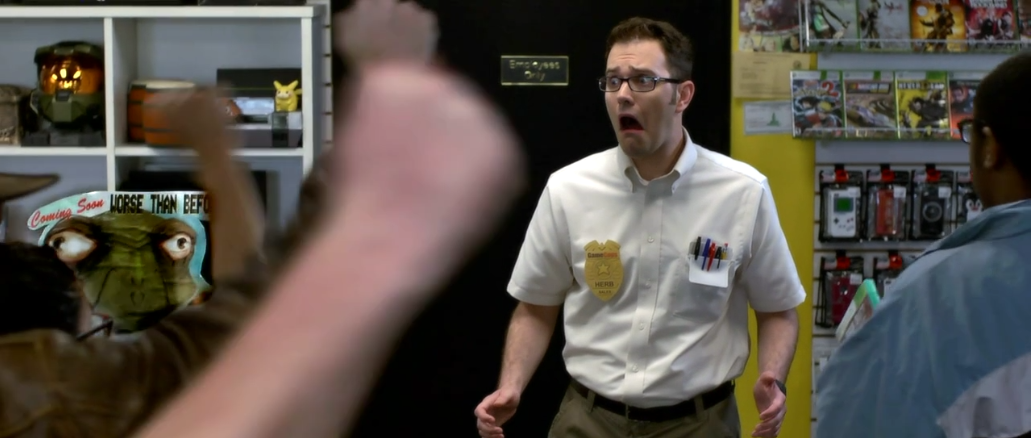
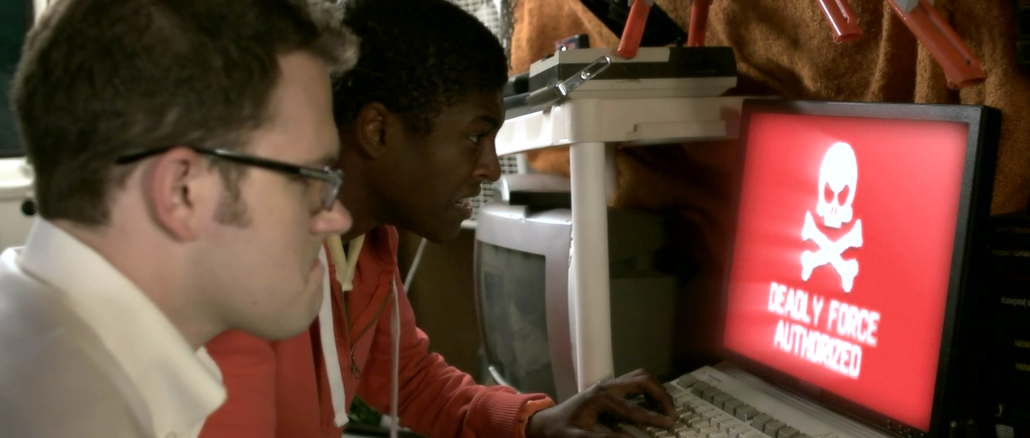
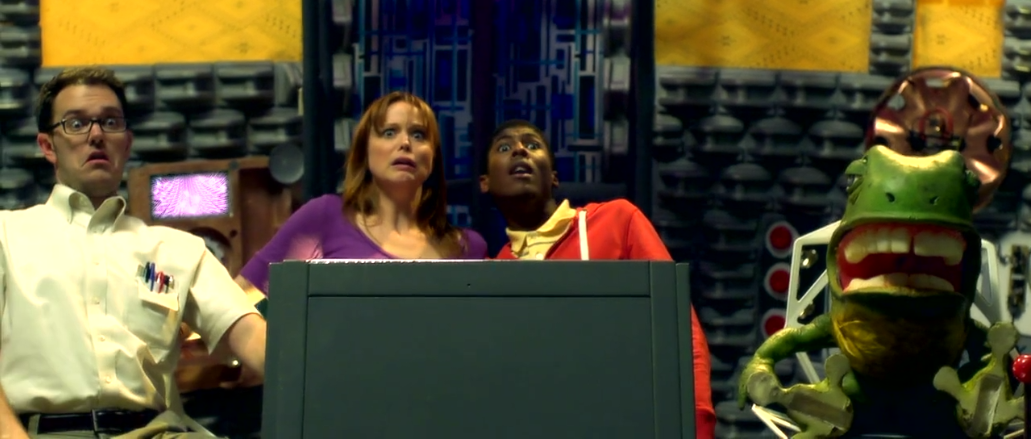
Are those silhouettes in front the Sun supposed to be a nod to the ET bike shot or Karate Kid? Or both? Neither?
Until you asked, I assumed it was a nod to ET…but surely he would have used the moon in that case? Night falls shortly after this anyway. So…maybe Karate Kid? Or both? Neither?
I just don’t understand how making the connection that there were two different rumors of alien artifacts in the desert didn’t successfully stretch to 110 minutes.
I feel like Stuart Saves His Family would have a few intersections with this for comparison.
If the timeline played out differently, I’d have expected the nerd’s reluctance to play Eee Tee was a reference to Rolfe’s own bizarre decision to make a huge public declaration of his intent not to watch Ghostbusters (2016).
The thing I find increasingly infuriating about him is all the times his criticism falls into various forms of “This game with 4k of memory should’ve had a full tutorial, because I can’t be bothered to read the manual” (Perhaps it is an oddity of the fact that I grew up in a semirural exurb, and thus buying a game ALWAYS involved a 40 minute drive home before I could play it, but I always read the manual before playing)